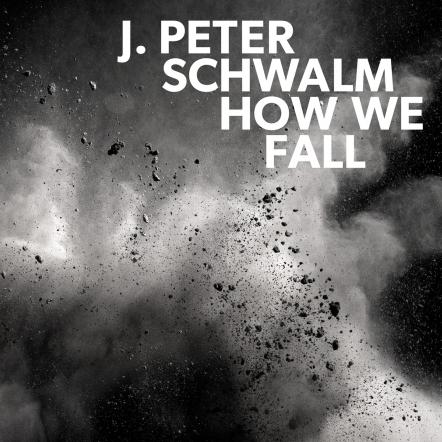New York, NY (Top40 Charts) For years J.
Peter Schwalm's compositions and productions have been impressive proof of the power of sound without words. More consistent than ever, on his new album How We Fall, he creates sound sculptures that transcend common categories. Their structures can take on rough or gently curved forms, unfold associative or contemplative effects, and may even make the listener shiver. Schwalm's feel for nuances, tension arcs and individual sounds is based on talent and many years of experience.
From 1998 J.
Peter Schwalm worked continuously with Brian Eno for six years, together they released the album Drawn From Life, wrote the soundtrack to Nicolas Winding Rfn's feature film Fear X, gave celebrated concerts in
Europe and Japan. Since 2006 Schwalm has been a regular guest at the Punktfestival in Kristiansand, Norway, where he distinguished himself and elsewhere as one of the few experienced live remixers, among others for members of the widely acclaimed Ensemble Modern. In spring 2016 Schwarm's last album The Beauty Of Disaster was released. Artistically, it revolved around a duality that shapes the visual arts and music as well as life itself: a certain melancholy that is always inherent in hope. The American PROG magazine praised: "Schwalm's pieces are nuanced and orchestrally textured, with meticulously sculpted, cinematic sound design..." and igloomag.com summed up: "Precise, skillful production work originates a crystal clear sound that intensifies the emotional charms and atmospheric aura of the peculiar, eclectic musicianship.".
"When I started going back into the studio in January 2017, the direction of the new production was still completely unclear to me," recalls J.
Peter Schwalm. The musician, born in Frankfurt am Main in 1970, had already distinguished himself through profound compositions and generally stood for rather dark facets of orchestral electronic music. In autumn 2016, an existential experience was added, leaving deep traces. A diagnosed brain tumour was to be surgically removed, which proved impossible during the operation. Schwalm nevertheless set to work under this impression, partly weakened by the inevitably following chemotherapy. Over the course of the year, pieces were created that reflect feelings such as restlessness, fear, despair and anger, but artistically process these emotions into abstract sounds. With that high degree of willingness to style and design that characterised Schwalm's earlier productions.
The artistic, surprising changes in sound and tuning Strofort undergoes as a lead piece by How We Fall set an example for the following 45 minutes. As suggestive as a soundtrack that doesn't need images, the composition of carefully arranged surfaces and imaginary scraps of language blowing across from another dimension, over rhythmic phrases and beats to a complex condensation in which supposed organ motifs are interwoven. In the course of the album there are pieces like Stormbruch, which think the concept of the slowly increasing Drones further. Or Strofort and Clingon, where the pulse plays an important role. "Compared to the previous record, this time I worked more with rhythmic details, including odd and opposite meters," states Schwalm.
The restart after the break due to illness was not easy for J.
Peter Schwalm at the beginning. "In the first few weeks after the operation, I listened through my archive to get distracted and inspired," he describes his new start. "Then I started designing miniatures on the piano, developing harmonies that I sent into my equipment. I came to the dramatic realization that I had to rediscover parts of my equipment because I couldn't remember all the functions." Popular or widespread plug-ins are not part of his repertoire, instead he uses analog and digital outboard effects to achieve his characteristic sound. He also developed the technique of multitrack composing, which he taught in theory and practice at the Punktfestival as well as at seminars in London, Tallinn and at the Filmakademie Baden-Württemberg. Over time, Schwalm transformed and abstracted his original ideas, varied and expanded the range of timbres until instruments he had initially used were no longer recognizable.
"During the process I realized that there are parallels between my personal experiences and emotions and the current social and political situation in the world," Schwalm recalls. This thought brought him to titles for some pieces, which sometimes associate a deceptive proximity to English terms. "In fact, however, they are partly names of real villages and stud farms," says Schwalm, who even has family ties to the region. "The locations are near a zone selected by the American military command during the Cold War of the 1980s as a drop zone for nuclear bombs to prevent possible attacking Russian military forces from occupying Germany." The strategists of the American armed forces called this environment a Fulda Gap.
Since his collaboration with Brian Eno, which included a joint performance with Krautrock legend Holger Czukay, J.
Peter Schwalm has composed for the Stuttgart Ballet, the Lyceum Theatre Sheffield, London choreographer Hofech Shechter and the series Das Neue Werk des NDR. Since 2008 Schwalm has been playing with the style-shaping electric guitarist and sound developer Eivind Aarset from Oslo, who has long been just as much a reference point for him as London bassist Tim Harries. In 2013 Schwalm was invited to perform a specially developed project with these two long-term partners and other musicians at the 44th German Jazz Festival in Frankfurt. In the same year he was commissioned by the London ensemble Icebreaker to develop a new piece from works by the electronic pioneers Kraftwerk. With
Kraftwerk Uncovered - A
Future Past Icebreaker and Schwalm toured successfully through England and Ireland. In 2016, after the release of The Beauty Of Disaster, Schwalm produced the band Chat Noir. He realized a live installation at the Frankfurter Kunstverein and presented an excerpt from his personal Bach adaptations at the Alte Oper Frankfurt. He is currently working on a radio play for Hessischer Rundfunk, for which he is writing music and texts as well as directing.
For J.
Peter Schwalm, How We Fall is a kind of snapshot that was taken in a relatively short time compared to earlier works. "The music represents a closed universe that reflects the moment and the circumstances in which it was created," he explains. All pieces are profoundly personal, and moreover figure as an intensive expression of a sound artist who no longer has to make any compromises. The music undoubtedly sounds dark, but never depressed, almost always gives a hint of light at least. With substantial and timeless quality, the album stands out from quickly consumable, trendy concepts. Instead of tickling key stimuli, How We Fall rewards repeated hearing with the revelation of ever new details.
TRACKS
1. Strofort
2. Battenfeld
3. Auua
4. Ibra
5. Gangesthal
6. Stormbruch
7. Clingon
8. Musles
9. Singlis
J.
Peter Schwalm - guitars, pianos, electronic devices acoustic and digital sound modules, mixing desks, drums and synths (except where indicated)
Eivind Aarset - additional guitars on 1,3,4,5,8,9
Tim Harries - additional bass on 1,4,5,6,7,9
All music written, composed, produced and performed by J.
Peter Schwalm in 2017
Additional Guitar by Eivind Aarset, On 1, 3, 4, 5, 8, 9
Additional Bass by Tim Harries, on 1, 4, 5, 6, 7, 9
Mastering by Mike Fossenkemper
Artwork by
Sophie Clements
Cover image and Title from "How We Fall",
Sophie Clements 2017
Photography of J.Peter Schwalm by Anja Jahn
Design by Toby Cornish, JuTojo
Executive Producer for RareNoiseRecords: Giacomo Bruzzo
CD, VINYL AND MULTIPLE DIGITAL FORMATS AVAILABLE IN STORES AND ONLINE ON JUNE 8, 2018 AND THROUGH WWW.RARENOISERECORDS.COM.
ABOUT THE LABEL - RareNoiseRecords was founded in 2008 by two Italians, entrepreneur Giacomo Bruzzo and music producer Eraldo Bernocchi. Located in London, the label's mission is to detect and amplify contemporary trends in progressive music, by highlighting their relation to the history of the art-form, while choosing not to be bound by pre-conceptions of genre. It seeks to become a guiding light for all those enamored by exciting, adventurous and progressive sounds. For further information and to listen please go to www.rarenoiserecords.com.























